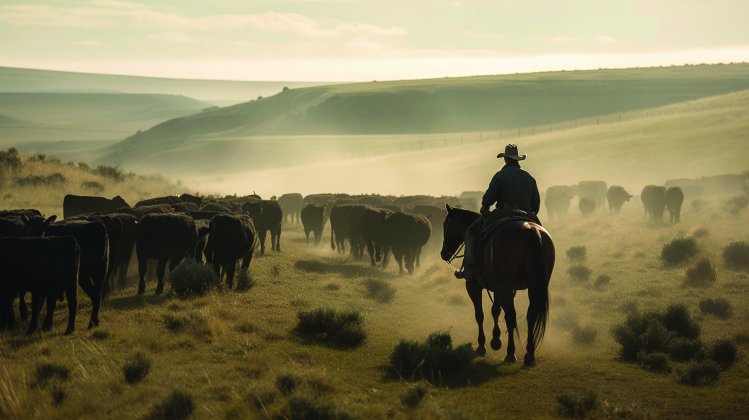The Civil War created cowboys with unbelievable adventures
Some sought a new life in Mexico
BY MURRAY MONTGOMERY - STAFF WRITER
One of my favorite sources for information about cowboys is The Trail Drivers of Texas by J. Marvin Hunter. Many of the stories in this book would make a good script for a Clint Eastwood movie. Hunter compiled and edited sketches that were submitted by old cowboys who tell of their experiences on the trail; factual accounts recalling the adventures of young men after the Civil War.
According to Hunter, who died in 1957, the original idea for this book came from George W. Saunders. At the Old Trail Drivers’ convention held at San Antonio in 1917, Saunders began encouraging cattlemen to submit their stories of life on the trail; he eventually asked Hunter to take charge of putting it all together. It took several years to bring the book to fruition, but it has become one of the greatest works to ever document the life of the Texas cowboy.
It is important to remember that after the Civil War, Texas was in a terrible financial condition. Men returning home from the war found a destitute economy, albeit a non-existent one. But the Lone Star State did have one thing; thousands of wild longhorn cattle hidden in the mesquite brush of south Texas, and there for the taking. It has been said that the men who had the courage to go after those cattle actually brought Texas back from financial ruin.
There is a rather outlandish story in the book about one of those adventurous men. The following sketch was submitted by a fellow named John H. Kritzer of Taylor, Texas. He began his story by saying that he lost $21,000 on one cattle drive. Kritzer’s life as a young man is one of those adventures that I found to be nearly beyond belief; so much so that it was he that I wanted to write about.
John Kritzer was born on a farm in Independence, Missouri. From 1861-1865 he fought in the Civil War as part of Joe Shelby’s Missouri Cavalry Brigade. But it was after the war that his adventure truly began. “When General Robert E. Lee surrendered, General Shelby and about three hundred of us boys concluded to take a ride across the Rio Grande and help Emperor Maximilian clean up Cortina, Juarez, Diaz, and a few other brigands. We started from Corsicana, Texas, all young daredevils as ever fired a shot at the Yankees in defense of our beloved Southland,” wrote Kritzer.
Just reading the previous quote leaves no doubt that Kritzer was a proud young man and mighty sure of himself and those with whom he rode. The group crossed into Mexico at Eagle Pass and had a firefight with some horse thieves. After that, he said they ran into some Mexican soldiers who started shooting at them from the rooftops of adobe houses. He said that because his group had Sharps rifles, they defeated the soldiers.
“The Mexican colonel, under protection of a white flag as large as a wagon sheet, and accompanied by his staff, came out to where we had our battle line, and told General Shelby that he was the ‘bravest American and had the bravest men’ that ever crossed the Rio Grande, and that if his people bothered our men or our horses, he would have them shot.”
The group rode on to Monterey and was met by French troops along with some friends who were already there with plans to build a colony. But before they could take possession of any land, things went bad. Maximilian was dethroned and executed. “So we abandoned the colony and returned to Missouri. After returning home I went to Wyoming and Montana and freighted for Uncle Sam,” said Kritzer.
The young man began driving cattle only to be captured by Osage Indians in 1871. “They held me prisoner for about an hour, and I suppose I would have been scalped, but the Indians saw the dust of a big herd being driven by Tim Scobey and turned me loose. Each warrior had one side of his face painted red and the other side painted black,” he recalled.
Later, he drove a herd to Abilene, Kansas, where he met Bill Hickok. He said “Wild Bill” was a desperate character. Kritzer said he went busted and lost $21,000 when a herd he was driving contacted tick fever. He made his last trail drive to Honeywell, Kansas, in 1882 and recovered from the previous loss. “We made $72,000 on this drive, lost only three steers and saw lightning kill them. This was my last trail work.”
I do not know about the rest of you, but I found this fellow’s story to be a wild one. I have read many accounts of trail drivers and although they were all unique, this one has to be the most unbelievable. Was it just a tongue-in-cheek story by a fellow with a sense of humor or did it really happen?
Kritzer ended his story with these words, “In conclusion, if you think this epistle of John to the cow punchers of the old Chisholm Trail is of any consequence in the way of reminiscence, or will it cast any luster on the fame of those brave and daring men of the saddle and trail, put it in your book. Farewell until we rattle our hocks on the other side.”


